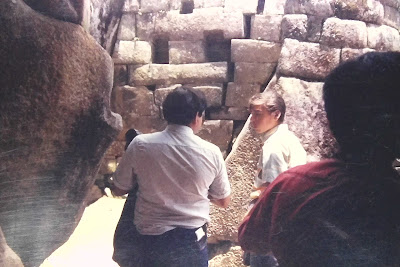We spent a lovely day up at Loon Mountain at the New Hampshire Highland Games today. I just got home a few minutes ago, and I'm writing up this quick blog post so you can read all about the genealogy and historical seminars being given this year. Besides the fantastic music, dancing, heavy athletics (caber tossing and stone throwing), sheep dog trials, over 60 clan tents, whiskey tastings, Scottish foods, Scottish gifts, and viewing lots of fellow visitors in kilts we also attended three historical seminars.
The first seminar we attended was "The Origins and Growth of Clan Tartans" by speaker Peter Eslea MacDonald. Peter is a famous Tartan Historian and Head of Research and Collections Scottish Tartans Authority. He is also the author of the book
The 1819 Key Pattern Book - One Hundred Original Tartans. This was a very interesting history of Scotland, highland dress, and the origins of what we think of as clan tartans. The history of clan tartans is fairly recent, just originating in the late 1700s or early 1800s, not in ancient times. Nonetheless, half the audience was wearing their clan tartans!
After some shopping, watching the sheep dog trials, and sharing a delicious meat pie called "bridie", we attended another seminar "Lost Lives, New Worlds: Unlocking the Story of the 1650 Scottish Soldiers Buried on Palace Green in Durham (UK)" presented by Dr. Christopher Gerrard. Dr. Gerrard is a Professor of Archaeology at Durham (UK not NH) and the team leader for the Scottish Soldiers Project. He also designed the exhibition on view now at the Saugus Ironworks National Historic Park in Saugus, Massachusetts. I have attended a presentation by University of Durham members at Saugus in the past (
You can read all about that HERE), but this presentation had some new information from the book of the same name as the lecture, which was published after I last visited Saugus, and since these prisoners of war were re-interred in Durham. That meeting in Saugus had about 30 attendees, and this presentation today filled an entire tent. Many of the attendees today were descendants of Scottish Prisoners of War (SPOW) from the battles of Dunbar and Worcester.

After a nice lunch and more shopping at the vendor tents, we attended our third seminar "Involuntary American: The Scottish Prisoners of 1650 and 1651" by Dr. Carol Gardner. This is the title of her new book, too. Dr. Gerrard's talk focused on the history of the battle, and the identification of the bodies found in Durham near the cathedral where the prisoners were locked up. Dr. Gardner's presentation focused on the forced migration and servitude of the Scottish teens and young men who were brought to New England. I also learned that other SPOWs went to Ireland, France, Barbados and Virginia, as well as to forced labor in England and Scotland. I bought a copy of her book (I already owned the book on the Durham archaeological dig) and I can't wait to read it. Two of my ancestors were SPOWs from the battle of Worcester -
William Munroe (who went to Lexington, Massachusetts) and
Alexander Thompson (who eventually went to Ipswich, Massachusetts.)
We spent the rest of our time at The Highland Games actually watching some of the heavy athletics (the hammer throw). We also saw the Royal Canadian Mounted Police Pipe & Drums and Dancers in the parade square. We heard the Red Hot Chili Peppers, lots of pipers, and other Scottish music.
It's not too late to attend these seminars! There is a full schedule of events at the website
https://nhscot.org/ but here are the other genealogy and history seminars you might find interesting (including the Sunday SPOW descendants gathering):
Saturday, September 21st
10:15 A Tour of Gaelic Languages by Dr. Emily McEwan (repeated)
10:30 Lost Lives, New Worlds by Dr. Christopher Gerrard (repeated)
11:45 Get Started Digging up your Roots by Joan Barnes (repeated)
1:30 By Different Routes: Scottish Prisoners & Ulster Scots in New England by Dr. Carol Gardner (repeated)
4:15 Involuntary Americans by Dr. Carol Gardner (repeated)
4:30 The Buchanan Tartans by Peter Eslea MacDonald
Sunday, September 22nd
10:30 Lost Lives, New Worlds by Dr. Christopher Gerrard (repeated)
10:30 The Use of Tartan as a Jacobite Symbol by Peter Eslea MacDonald
11:00 Dunbar (and Worcester) Descendants Gathering
12 noon By Different Routes: Scottish Prisoners & Ulster Scots in New England by Dr. Carol Gardner (repeated)
1:30 A Tour of Gaelic Languages by Dr. Emily McEwan (repeated)
1:30 Get Started on Diggin gup your Roots by Joan Barnes (repeated)
2:30 The Food and History of the Burns Supper by Gary Maclean
3:00 The Scottish Prisoners of 1650 & 1651 by Dr. Carol Gardner
3:00 Outlander and the Real Tartans of 1745 by Peter Eslea MacDonald
4:30 Key Online Sites for Scottish Genealogy by Joan Barnes
For the Truly curious:
The New Hampshire Scots Official Website (including Highland Games information):
https://nhscot.org
My blog post "The Discovery of Scots Prisoners of War at Durham Cathedral! How is this Important to New England Genealogy?"
https://nutfieldgenealogy.blogspot.com/2015/09/discovery-of-scots-prisoners-of-war-at.html
My blog post "The University of Durham Team is Reaching Out to Descendants of 17th Century Scottish Prisoners":
https://nutfieldgenealogy.blogspot.com/2016/10/university-of-durham-team-is-reaching.html
My blog post about William Munroe, Scottish prisoner of war:
https://nutfieldgenealogy.blogspot.com/2012/06/surname-saturday-munroe-of-lexington.html
My blog post about Alexander Thompson, Scottish prisoner of war:
https://nutfieldgenealogy.blogspot.com/2014/05/surname-saturday-thomson-thompson-of.html
 |
| The Clan Thompson Tent |
 |
| The RCMP (the Mounties) Pipe & Drum Band |
 |
| The Sheep Dog Trials |
------------------------------
Heather Wilkinson Rojo, "It's Not Too Late to Attend the Highland Games and Scots Prisoner of War Reunion!",
Nutfield Genealogy, posted September 20, 2019, ( https://nutfieldgenealogy.blogspot.com/2019/09/its-not-too-late-to-attend-highland.html: access [accesss date]).

























































